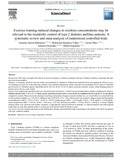Mostrar el registro sencillo del ítem
Exercise training-induced changes in exerkine concentrations may be relevant to the metabolic control of type 2 diabetes mellitus patients: a systematic review and meta-analysis of randomized controlled trials
| dc.creator | García Hermoso, Antonio | es_ES |
| dc.creator | Ramírez Vélez, Robinson | es_ES |
| dc.creator | Díez, Javier | es_ES |
| dc.creator | González, Arantxa | es_ES |
| dc.creator | Izquierdo Redín, Mikel | es_ES |
| dc.date.accessioned | 2023-02-20T12:31:54Z | |
| dc.date.available | 2023-02-20T12:31:54Z | |
| dc.date.issued | 2022 | |
| dc.identifier.citation | García-Hermoso, A., Ramírez-Vélez, R., Díez, J., González, A., & Izquierdo, M. (2022). Exercise training-induced changes in exerkine concentrations may be relevant to the metabolic control of type 2 diabetes mellitus patients: A systematic review and meta-analysis of randomized controlled trials. Journal of Sport and Health Science, S2095254622001107. https://doi.org/10.1016/j.jshs.2022.11.003 | en |
| dc.identifier.issn | 2095-2546 | |
| dc.identifier.uri | https://hdl.handle.net/2454/44762 | |
| dc.description.abstract | Background: This study investigates the effects of exercise training on exerkines in patients with type 2 diabetes mellitus to determine the optimal exercise prescription. Methods: A systematic search for relevant studies was performed in 3 databases. Randomized controlled trials investigating the effects of exercise training on at least one of the following exerkines were included: adiponectin, apelin, brain-derived neurotrophic factor, fetuin-A, fibroblast growth factor-21, follistatin, ghrelin, interleukin (IL)-6, IL-8, IL-10, IL-15, IL-18, leptin, myostatin, omentin, resistin, retinol-binding protein 4, tumor necrosis factor-a, and visfatin. Results: Forty randomized controlled trials were selected for data extraction (n = 2160). Exercise training induces changes in adiponectin, fetuin-A, fibroblast growth factor-21, IL-6, IL-10, leptin, resistin, and tumor necrosis factor-a levels but has no significant effects on apelin, IL-18, and ghrelin compared to controls. Physical exercise training favored large and positive changes in pooled exerkines (i.e., an overall effect size calculated from several exerkines) (Hedge’s g = 1.02, 95% confidence interval (95%CI): 0.761.28), which in turn were related to changes in glycated hemoglobin (mean difference (MD) = 0.81%, 95%CI: 0.95% to 0.67%), fasting glucose (MD = 23.43 mg/dL, 95%CI: 30.07 mg/dL to 16.80 mg/dL), waist circumference (MD = 3.04 cm, 95%CI: 4.02 cm to 2.07 cm), and body mass (MD = 1.93 kg, 95%CI: 2.00 kg to 1.86 kg). Slightly stronger effects were observed with aerobic, resistance, or high-intensity interval protocols at moderate- to vigorous-intensity and with programs longer than 24 weeks that comprise at least 3 sessions per week and more than 60 min per session. Conclusion: Exercise training represents an anti-inflammatory therapy and metabolism-improving strategy with minimal side effects for patients with type 2 diabetes mellitus. | en |
| dc.format.mimetype | application/pdf | en |
| dc.language.iso | eng | en |
| dc.publisher | Elsevier | en |
| dc.relation.ispartof | Journal of Sport and Health Science (2022) 1-11 | en |
| dc.rights | © 2022 Published by Elsevier B.V. on behalf of Shanghai University of Sport. This is an open access article under the CC BY-NC-ND license. | en |
| dc.rights.uri | http://creativecommons.org/licenses/by-nc-nd/4.0/ | |
| dc.subject | Adipokines | en |
| dc.subject | Exercise training | en |
| dc.subject | Hepatokines | en |
| dc.subject | Myokines | en |
| dc.title | Exercise training-induced changes in exerkine concentrations may be relevant to the metabolic control of type 2 diabetes mellitus patients: a systematic review and meta-analysis of randomized controlled trials | en |
| dc.type | Artículo / Artikulua | es |
| dc.type | info:eu-repo/semantics/article | en |
| dc.date.updated | 2023-02-20T12:27:04Z | |
| dc.contributor.department | Ciencias de la Salud | es_ES |
| dc.contributor.department | Osasun Zientziak | eu |
| dc.rights.accessRights | Acceso abierto / Sarbide irekia | es |
| dc.rights.accessRights | info:eu-repo/semantics/openAccess | en |
| dc.identifier.doi | 10.1016/j.jshs.2022.11.003 | |
| dc.relation.publisherversion | https://doi.org/10.1016/j.jshs.2022.11.003 | |
| dc.type.version | Versión publicada / Argitaratu den bertsioa | es |
| dc.type.version | info:eu-repo/semantics/publishedVersion | en |



